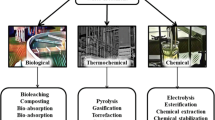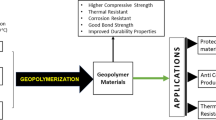Abstract
In order to provide a theoretical basis for verifying the feasibility of partially replacement from the peanut shell to aluminum powder in the rock-breaking incendiary agent, its decomposition behavior was studied. A rock-breaking incendiary agent including peanut shell, aluminum and potassium nitrate was analyzed using DTA-TG and TG-FTIR experiments. An accurate kinetic model based on the analysis was proposed to describe the decomposition of the rock-breaking incendiary agent with peanut shell by applying an isoconversional method and non-linear regression to the TG data. We found that the thermal decomposition for the rock-breaking incendiary agent with peanut shell involves three reactions. Specifically, the peanut shell was pyrolyzed and then reacted with the potassium nitrate. After that, the newly generated coke from the peanut shell could be attended into the thermite reaction. The decomposition followed a 1.0738-th Prout–Tompkins equation with autocatalysis, with a differential kinetic mechanism function of f(α) = (1 − α)1.0738·α0.0888. Lastly, the thermodynamic parameters and theoretical volume of gas produced were studied. The self-accelerating decomposition temperature and the critical temperature of thermal runway were 882.50 K and 949.90 K, respectively. The theoretical volume of gas produced was 223.60 cm3 g−1, 2.64 times than that without peanut shell. These results show that the thermal stability of the rock-breaking incendiary agent with peanut shell is higher than that without peanut shell. In addition, adding peanut shell could be beneficial to improve the effect of breaking rock and reduce its costs.










Similar content being viewed by others
Data availability
Not applicable.
References
Sanchidrián JA, Segarra P, López LM (2007) Energy components in rock blasting. Int J Rock Mech Min Sci 44:130–147
Tian X, Song Z, Wang J (2019) Study on the propagation law of tunnel blasting vibration in stratum and blasting vibration reduction technology. Soil Dyn Earthq Eng 126:105813
Fan C, Ge J (2020) Dynamic calculation method of vibration response of building blasting based on differential equation. Environ Technol Innov 20:101178
Zhang Z, Zhou C, Remennikov A, Wu T, Lu S, Xia Y (2021) Dynamic response and safety control of civil air defense tunnel under excavation blasting of subway tunnel. Tunn Undergr Space Technol 112:103879
Xu M, Li X, Liu T, Luo Y, Huang J, Wang G, Wang Y, Gao W (2021) A study on hollow effect and safety design of deep crossing caverns under blasting vibration. Tunn Undergr Space Technol 111:103866
Wang X, Li J, Zhao X, Liang Y (2022) Propagation characteristics and prediction of blast-induced vibration on closely spaced rock tunnels. Tunn Undergr Space Technol 123:104416
Alghamri R, Al-Tabbaa A (2020) Self-healing of cracks in mortars using novel PVA-coated pellets of different expansive agents. Constr Build Mater 254:119254
Shao J, Zhu H, Xue G, Yu Y, Mirgan Borito S, Jiang W (2021) Mechanical and restrained shrinkage behaviors of cement mortar incorporating waste tire rubber particles and expansive agent. Constr Build Mater 296:123742
Cao F, Liu Y, Yan P (2021) Properties and mechanism of the compound MgO expansive agent (CMEA) produced by calcining the mixture of dolomite and serpentine tailings. Constr Build Mater 277:122331
Zhong Z, Zhang H, Hu Y, Lou R, Tao P, Liu J (2023) Experimental and numerical explorations on the optimized applications of SCDA in cracking concrete blocks. Measurement 206:112335
Jiang Z, Zheng W, Wang Y, Sun P, Lu D, Sun L (2023) The use of soundless chemical demolition agents in reinforced concrete deep beam demolition: experimental and numerical study. J Build Eng 69:106260
Kaji Y, Ishikawa T, Sugihara H (2019) Expansion agent utilizing thermite reaction. Sci Technol Energ Mater 80:50–53
Oh S, Park S, Min G, Park H, Yoo Y, Cho S (2020) Deflagration characteristics of thermite reaction mixtures under decoupled charges. Sci Technol Energ Mater 81:114–120
Xie X, Zhang X, Wang L, Ding Y (2017) Application of a high-enemy incendiary crushing rock charge column. Eng Blast 23:76–80
Solarte-Toro JC, González-Aguirre JA, Poveda Giraldo JA, Cardona Alzate CA (2021) Thermochemical processing of woody biomass: a review focused on energy-driven applications and catalytic upgrading. Renew Sustain Energy Rev 136:110376
Glushkov DO, Nyashina GS, Anand R, Strizhak PA (2021) Composition of gas produced from the direct combustion and pyrolysis of biomass. Process Saf Environ Prot 156:43–56
Ji W, Richter F, Gollner MJ, Deng S (2022) Autonomous kinetic modeling of biomass pyrolysis using chemical reaction neural networks. Combust Flame 240:111992
Wu Y, Liu B (2022) Mg(NO3)2·6H2O-modified porous carbon derived from peanut shell: formation mechanism and efficient removal of p-nitrophenol. Reac Kinet Mech Cat 135:2085–2098
Santos VO, Araujo RO, Ribeiro FCP, Colpani D, Lima VMR, Tenório JAS, Coleti J, Falcão NPS, Chaar JS, de Souza LKC (2022) Analysis of thermal degradation of peach palm (Bactris gasipaes Kunth) seed using isoconversional models. Reac Kinet Mech Cat 135:367–387
Kumar M, Rai D, Bhardwaj G, Upadhyay SN, Mishra PK (2021) Pyrolysis of peanut shell: kinetic analysis and optimization of thermal degradation process. Ind Crops Prod 174:114128
De Lucia FC, Giri L, Pesce-Rodriguez RA, Wu C, Dean SW, Tovar TM, Sausa RC, Wainwright ER, Gottfried JL (2022) Commercial aluminum powders, part I: particle size characterization and slow heating rate thermal analysis. Powder Technol 399:117162
Pourmortazavi SM, Kohsari I, Zandavar H, Koudehi MF, Mirsadeghi S (2019) Electrospinning and thermal characterization of nitrocellulose nanofibers containing a composite of diaminofurazan, aluminum nano-powder and iron oxide nanoparticles. Cellulose 26:4405–4415
Pourmortazavi SM, Mirzajani V, Farhadi K (2019) Thermal behavior and thermokinetic of double-base propellant catalyzed with magnesium oxide nanoparticles. J Therm Anal Calorim 137:93–104
Dourari M, Tarchoun AF, Trache D, Abdelaziz A, Barkat T, Tiliouine R, Bekhouche S, Bessa W (2023) Elucidating the effect of nitrocellulose-encapsulated MgAl–CuO on the thermal behavior of double base propellant based on nitrocellulose and diethylene glycol dinitrate. Reac Kinet Mech Cat 136:2309–2325
Venkatesh M, Ravi P, Tewari SP (2013) Isoconversional kinetic analysis of decomposition of nitroimidazoles: Friedman method vs Flynn-Wall-Ozawa method. J Phys Chem A 117:10162–10169
Juibari NM, Eslami A (2017) Investigation of catalytic activity of ZnAl2O4 and ZnMn2O4 nanoparticles in the thermal decomposition of ammonium perchlorate. J Therm Anal Calorim 128:115–124
Trache D, Maggi F, Palmucci I, DeLuca LT (2018) Thermal behavior and decomposition kinetics of composite solid propellants in the presence of amide burning rate suppressants. J Therm Anal Calorim 132:1601–1615
Bruijn TJWD, Jong WAD, Berg PJVD (1981) Kinetic parameters in Avrami–Erofeev type reactions from isothermal and non-isothermal experiments. Thermochim Acta 45:315–325
Pielichowska K (2016) The influence of polyoxymethylene molar mass on the oxidative thermal degradation of its nanocomposites with hydroxyapatite. J Therm Anal Calorim 124:751–765
Xie Q, Zhang Z, Zhang L, Xie Y, Liu W, Chen H (2019) Thermal decomposition behavior and kinetics for nitrolysis solution from the nitration of hexamethylenetetramine. Reac Kinet Mech Cat 128:645–662
Zhang Y, Chen H, Chen T (2014) Drying kinetics of RDX under atmospheric pressure and vacuum conditions. Energy Convers Manag 80:266–275
Xie Q, Xie Y, Liu W, Zhang L, Li S, Chen H (2020) Thermal decomposition behaviour and kinetics of a mixed solution: n-propyl nitrate and nitric acid solution. J Therm Anal Calorim 140:1801–1810
Rtibi D, Boa D, Hellali D, Zamali H (2017) Experimental investigation and calculation of the phase diagram of the isobaric binary system (KNO3+TlNO3). J Alloys Compd 721:419–430
Che Y, Hao J, Zhang J, Qiao Y, Li D, Tian Y (2018) Vacuum residue thermal cracking: product yield determination and characterization using thermogravimetry-Fourier transform infrared spectrometry and a fluidized bed reactor. Energy Fuels 32:1348–1357
Nel HA, Chetwynd AJ, Kelly CA, Stark C, Valsami-Jones E, Krause S, Lynch I (2021) An untargeted thermogravimetric analysis-Fourier transform infrared-gas chromatography-mass spectrometry approach for plastic polymer identification. Environ Sci Technol 55:8721–8729
Jiang J, Luo J, Wu Y, Qu W (2023) The influence of ammonium polyphosphate on the smoke toxicity of wood materials. Thermochim Acta 725:179534
Cui S, Yang T, Zhai Y, Zhu Y, Yu Z, Kai X (2023) Investigation on the characteristics and interaction of co-pyrolysis of oil shale and peanut shell. Fuel 340:127502
Yang H (2021) Study on thermal safety of controllable crushing agent. Anhui University of Science and Technology, Huainan
Burnham AK (2000) Application of the Šesták-Berggren equation to organic and inorganic materials of practical interest. J Therm Anal Calorim 60:895–908
Bohn MA (2014) Problems and faulty uses with the Prout–Tompkins description of autocatalytic reactions and the solutions. J Therm Anal Calorim 116:1061–1072
Ellern H (1968) Military and civilian pyrotechnics. Chemical Publishing Co., New York
Liu R, Liu G, Yousaf B, Abbas Q (2018) Operating conditions-induced changes in product yield and characteristics during thermal-conversion of peanut shell to biochar in relation to economic analysis. J Clean Prod 193:479–490
Acknowledgements
This work was supported by Natural Science Research Project of Anhui Educational Committee (Project No. 2022AH050842), Scientific Research Foundation for High-level Talents of Anhui University of Science and Technology (Project No. 2021yjrc08) and University-level Military Special Projects of Anhui University of Science and Technology (Project No. JGZX2022-01).
Author information
Authors and Affiliations
Corresponding author
Additional information
Publisher's Note
Springer Nature remains neutral with regard to jurisdictional claims in published maps and institutional affiliations.
Rights and permissions
Springer Nature or its licensor (e.g. a society or other partner) holds exclusive rights to this article under a publishing agreement with the author(s) or other rightsholder(s); author self-archiving of the accepted manuscript version of this article is solely governed by the terms of such publishing agreement and applicable law.
About this article
Cite this article
Xie, Q., Zhu, ML., Wang, HX. et al. Thermal decomposition behavior and kinetics of rock-breaking incendiary agent based on peanut shell. Reac Kinet Mech Cat 136, 3105–3126 (2023). https://doi.org/10.1007/s11144-023-02513-w
Received:
Accepted:
Published:
Issue Date:
DOI: https://doi.org/10.1007/s11144-023-02513-w




